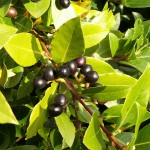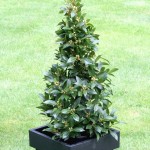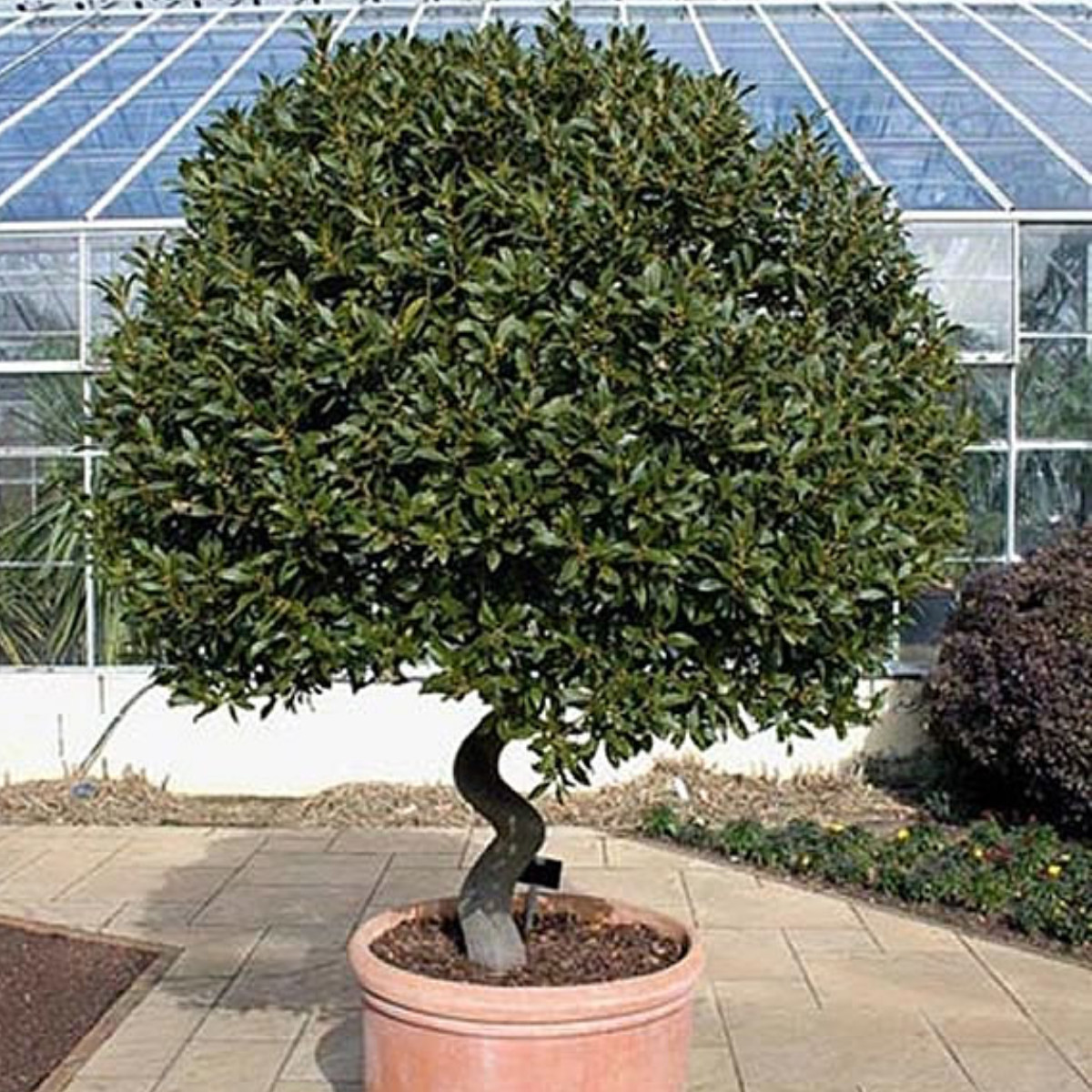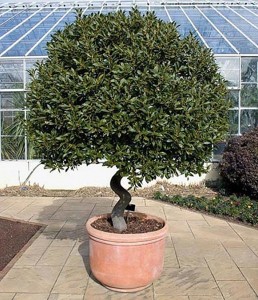Family: Lauraceae
Distribution and habitat: Laurus nobilis is native to the Mediterranean region. It can vary greatly in size and height, sometimes reaching 1018m (3359 feet) tall.
Description: Laurus nobilis is an aromatic evergreen tree or large shrub with a broad base with many stems. The stems bear dense, pointed, elliptical leaves, rather leathery in texture, bright green when young and darker green when mature. The leaves are 612cm (2.5-5 inch) long and 24cm (0.8-1.6 inch) broad with smooth margins; on some leaves the margin undulates. The aroma of the leaves is not free; leaves have to be rubbed to release it.
The Laurus nobilis is dioecious (unisexual), with male and female flowers on separate plants. Each flower is pale yellow-green, about 1cm (0.4 inch) diameter, and they are borne in pairs beside a leaf. The fruit is a small, shiny black berry about 1cm (0.4 inch) long. Potted grown specimens seldom flower and fruit.
Houseplant care: Laurus nobilis thrives in containers, making an excellent houseplant. It can be turned into topiary (shrubs cut or trained into specified shapes) specimens which can be shaped into pyramid, ball or lollipop standards and some have ornately plaited or spirally trained stems.
Topiary-trained Laurus nobilis are trimmed with secateurs during summer to encourage a dense habit and to maintain a balanced shape. Prune new shoots to a bud facing in the direction of the desired growth.
Shrubs can be trimmed into shape by simply cutting back to a lower leaf or bud in spring or summer.
Remove any dried foliage by lightly pruning. Mature plants can be hard pruned, but should be considered that it is a slow grower and will take long to recover.
During the warm seasons, Laurus nobilis can be moved outdoors, especially if watered regularly and positioned in a sheltered spot.
Light: Give Laurus nobilis bright filtered light all years long.
When moving the plant outside in warmer weather, it must be acclimated to the sun or the leaves will burn.
Temperature: Laurus nobilis is growing well in normal room temperature. It can withstand temperatures down to -5C (23F), but frost and cold winter winds can damage the foliage. Take the plant indoors if temperatures fall below -5C(23F).
Watering: Water regularly but sparingly during growing season. Do not overwater. Water less during winter, only to make sure the root ball does not dry out.
Mature plants will tolerate some degree of negligence, but do not let it sit for long periods without water.
Feeding: Use a standard liquid feed every two weeks from mid-spring to late summer. Do not feed the shrub during the winter period and avoid high concentrations of fertiliser.
Potting and repotting: MoveLaurus nobilis in one size larger pot every two years in spring. Use a soil-based potting mixture with extra grit added to improve stability and drainage. Moved up the plant as it grows to the largest pot size that is convenient and thereafter maintained at that size by pruning the rootball and top pruning. Lift the plant out of its pot and tease off a third of the roots before adding fresh potting mixture and checking drainage. Remove and replace the top 5cm (2 inch) of compost from the top of the container.
Garden Culture: Laurus nobilis is a slow growing evergreen tall shrub that if left untrimmed and grown in the ground (where the climate allows) will eventually grow into a medium sized tree. Prune it to shape when required. Plants may suffer cold or wind damage to the current season's growth, which can be pruned out in the spring
Position: A sunny to partly shaded exposure is ideal for Laurus nobilis.
The plant can tolerates strong winds but not maritime exposure.
Soil: Laurus nobilis is not too particular about the soil. However, a well-drained soil is important.
Plant it at the same depth as it was in its original pot. Bay roots are very shallow. Use caution when weeding or cultivating around at the base of the tree.
Irrigation: Follow a regular watering schedule during the first growing season to establish a deep, extensive root system. Water it at least once a week or enough to keep the soil consistently moist but not soggy. Increase watering to twice per week during extremely hot temperatures or in drought-like conditions. Watering can be reduced once established.
Laurus nobilis is drought tolerant, but appreciates regular deep watering. Always allow the soil to dry out between waterings, so the roots do not rot.
Fertilising: For best results fertilise with a long term slow release fertiliser in early Spring.
Companion plants: The versatile habit of Laurus nobilis allows pairing it with a variety of Mediterranean plants. Grow it along with other fragrant, culinary herbs such asRosmarinus officinalis (Rosemary), Lavandula species (Lavender) and Origanum vulgare (Oregano). Adding other trees which produce edibles fruits like Punica granatum (Pomegranate), Citrus species (Citrus) and Olea europaea (Olive) will turn this garden in true kitchen garden.
Propagation: Laurus nobilis can be propagated from seed collected in the autumn. However, male and female plants must be grown to obtain seed. Remove the fleshy outer casing and sow as soon as possible. If seed has dried or is bought, soak in warm water for 24 hours before sowing. Seed may take six months to one year to germinate. Prick out the seedlings into individual pots once they are large enough to handle and grow them on in the greenhouse for at least their first year.
Also Laurus nobilis can be propagated by taking semi-ripe cuttings in late summer. Wood that is just beginning to harden makes the best cuttings, but even these take up to three months to root under the best conditions. Cut 10-12cm (4-4.5 inch) of mature side shoot with heel. Pinch off the leaves from the bottom of the cutting. Dip the cut end of the cutting into water and then into the rooting hormone until the bottom 3cm (1 inch) of the cutting is coated in the powder. Pot the cutting into a 8cm (3 inch) pot size filled with moistened equal parts mixture of peat moss and sand or perlite. Make a hole in the middle of the pot and insert the cutting 3cm (1 inch) below the leaves, then press the potting mixture around the cutting. Seal the pot into a plastic bag or propagating case and place it in indirect sunlight. New growth indicate that the rooting has occurred. At this moment remove the bag and water the cuttings enough to keep the potting mixture just moist.
When the new plant is well established in about six months move it into one pot size larger containing the same potting mixture used for adult plant. Thereafter treat it in same way as a mature Laurus nobilis.
Another propagating method is by layering the plant. Layering is often successful, but slower than cuttings and require extensive gardening skills.
Problems:
Plants in containers are prone to leaf spots caused by waterlogged roots or wet weather conditions. This condition is usually indicating that the compost has become old and tired.
Treatment: Repot the shrub in spring into fresh, well-drained potting mixture.
Nutrient deficiency can cause leaves yellowing for in container-grown plants but is more commonly caused by waterlogged compost or cold weather damage. Older leaves will shed naturally in low numbers.
Treatment: Feed the plant and reduce watering during the cold season. Repot the shrub in spring into fresh recommended potting mixture if neccessary.
During harsh winters, Laurus nobilis may developed cracking and peeling bark, especially on the lower main stems. The cause is the winter cold and possibly other stress factors such as fluctuating soil moisture levels. Though the damage looks alarming it appears to be invariably fatal. If the rest of the plant is growing normally or recovering from winter damage (recovery should be apparent by midsummer if it is to happen) no action is needed.
Treatment: However, if the growth above the damaged area is dead, remove the dead parts cutting to healthy wood or to near soil level. Recovery from lower down or soil level often occurs.
Laurus nobilis are subject to scale insects.
Treatment: It can be treated with horticultural oil or wipe them away with a cotton swab or cotton ball dipped into rubbing alcohol.
Laurus nobilis can be susceptible to powdery mildew and black mold. These tend to grow on the leaves and branches of trees that do not get enough sunlight or that accumulate moisture on their leaves that does not evaporate quickly during the day.
Treatment: For anthracnose, mold and mildew, remove all affected foliage using sterile pruning. Dispose of all plant debris removed from the plant and that is lying under the plant. In most cases, this should enable the plant to contain the spread of infection naturally. Continue to monitor the plant for signs of further infection and removed impacted foliage as necessary.
Uses: Laurus nobilis makes a popular container plant being grown as a shrub or even topiary specimen.
It is an effective slow growing hedging or screening plant that can be kept clipped from 1-4m (3-13 feet) or left to grow into a medium sized tree. Its dark green leaves will provide an ideal backdrop for other plants. Also it is an excellent plant for topiary and is well suited to formal gardens. Its dried leaves are used in cooking and so it is an essential plant in any kitchen garden.
Culinary, the leaf is added at the beginning of cooking soups and stews and slowly imparts a deep, rich flavor. The leaf is left whole so it can be retrieved before serving the dish. To harvest leaves from a privately owned tree, cut off small branch with the desired number of leaves attached. Allow the entire branch to dry out. Remove the leaves from the branch and store them in a container to maintain the flavour of the leaf.
Height: 15-20 ft. (4.7-6 m)
Hardiness zone: 8a - 11









